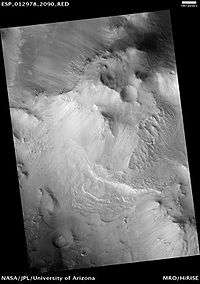Curie (Martian crater)
Curie Crater is an impact crater in the Oxia Palus quadrangle of Mars, located at 29.1° N and 4.8° W. It is 114.1 km in diameter and was named after Pierre Curie, a French physicist-chemist (1859-1906).[1]
 Curie Crater, as seen by HiRISE. | |
| Planet | Mars |
|---|---|
| Coordinates | 29.1°N 4.8°W |
| Diameter | 114.1 km |
| Eponym | Pierre Curie, a French physicist-chemist (1859-1906) |
Impact craters generally have a rim with ejecta around them, in contrast volcanic craters usually do not have a rim or ejecta deposits. As craters get larger (greater than 10 km in diameter) they usually have a central peak.[2] The peak is caused by a rebound of the crater floor following the impact.[3]
 Curie Crater, as seen by CTX camera (on Mars Reconnaissance Orbiter).
Curie Crater, as seen by CTX camera (on Mars Reconnaissance Orbiter). Channels in Curie Crater, as seen by CTX camera (on Mars Reconnaissance Orbiter). Note: this is an enlargement of the previous image.
Channels in Curie Crater, as seen by CTX camera (on Mars Reconnaissance Orbiter). Note: this is an enlargement of the previous image.- Close-up of layers in central mound of Curie Crater, as seen by HiRISE.
 A topographic map created using Mars Orbiter Laser Altimeter (MOLA) data. This map shows the elevation of the central peak and rim of Curie crater relative to Martian areoid.
A topographic map created using Mars Orbiter Laser Altimeter (MOLA) data. This map shows the elevation of the central peak and rim of Curie crater relative to Martian areoid.
See also
References
| Wikimedia Commons has media related to Curie (Martian crater). |
- "Gazetteer of Planetary Nomenclature | Curie". usgs.gov. International Astronomical Union. Retrieved 4 March 2015.
- http://www.lpi.usra.edu/publications/slidesets/stones/
- Hugh H. Kieffer (1992). Mars. University of Arizona Press. ISBN 978-0-8165-1257-7. Retrieved 7 March 2011.
This article is issued from Wikipedia. The text is licensed under Creative Commons - Attribution - Sharealike. Additional terms may apply for the media files.